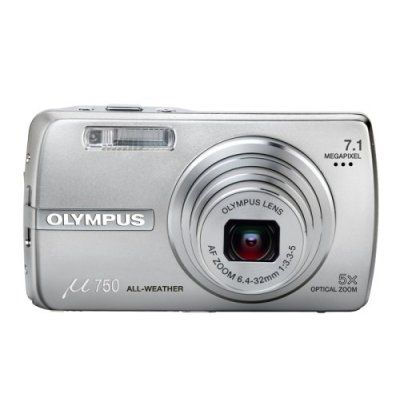The wedge shaped Olympus Mju 750 slots into the company’s range between the Mju 1000 and the Tonka-tough Mju 725SW, which boasts full shock and waterproofing, compared here with “mere” weatherproofing. In fact, the camera can contend with “splashing water” from any direction (read rain, snow and sleet) but cannot be submerged.
Our quick take
Nice to look at, very pocketable, weatherproof and able to create images able to be printed at A3 or larger (with the caveat on shadow noise), the Olympus Mju 750 would make a great snapper for anyone: novice photographer, outdoor types or those who’d rather spend their time partying down the pub and dodging spillages of wine and beer while snapping away.

Olympus Mju 750 digital camera - 4.5 / 5
| FOR | AGAINST |
|---|---|
|
|
The small, lightweight camera is a slender and graceful 120g, has a nicely designed aluminum body with an unusual-for-this-sector-of-the-market 5x optical zoom lens, the “norm” being 3x zoom. It provides a 36-180mm focal range but because longer focal lengths can be susceptible to camera shake, Olympus has included a image stabilisation system to contend with it.
First, there’s a CCD-shift anti-shake system that quickly moves the 7.1-megapixel sensor to compensate for any wobbly-hand syndrome, particularly at those longer focal lengths or slower shutter speeds. Backing it up is a high sensitivity mode that gives (up to) an ISO 1600 maximum; ISO range starts at ISO 80, running through the “usual” range of 100, 200, 400 and 800 ISO.
BrightCapture Technology is utilised to bring into play the higher sensitivities and to brighten the excellent, 2.5-inch colour screen. However, in the bright conditions I used this camera, the screen was still hard to see properly in direct light. An optical finder would have made things much easier but this omission is now very common on many small digital compacts.
In terms of handling, the small design sits well in the hand and while most controls are simple to use, I found the shutter release and four-way jog buttons slightly problematic. For the shutter release, pressing the button to focus is fine, but the second pressure – to take a shot – is quite deep, meaning your finger position must change to push it in enough to trigger the shutter.
At slower shutter speeds, (even with image stabilisation on) this can be problematic in terms of camera shake, while it also makes general shooting uncomfortable. The four-way jog buttons are very small and although easy to press in the right direction, if you have larger fingers (like mine) the adjacent, menu, print, display and delete controls can be pressed at the same time.
Talking of menus, these are simple and clear to use with a selection of options on the screen, which you navigate to and then must press the centrally placed OK/FUNC(tion) button. On the down side, the dual menu entry system is slow to use. On the up side, pressing the FUNC button give fast access to key shooting options such as white balance, sensitivity and metering modes.
A mode dial above the four-way button gets the camera into its main, well, shooting modes of playback, its general snapping (it’s a Program AE mode) position, the scene mode (where you can get at the 23 subject program modes that include three underwater settings (for use with a waterproof housing), the usual array of portrait and landscape modes, night scene and sports modes) and a very good Guide mode.
Guide mode provides a menu that describes a range of shooting options, you pick the closest to what you’re about to snap, select from the range of options presented in terms of the subject and the camera is then set up to cater to that subject as best it is able. Very clever and very cool for novices or anyone not sure of what to do with the camera for a specific subject.
Last up on the mode dial, there’s nice movie mode, that can shoot to the limit of the storage, which, this being an Olympus, utilises xD-Picture Cards, although there is a very modest internal storage, enough for just five top quality images.
And talking of image quality, the Mju 750 actually takes nice pictures. Slightly worrying is some noise in shadows even at lower sensitivities and slight purple fringing. Noise becomes an issue over ISO 400 and very noticeable over ISO 800.
However, colour is excellent (though of course it can be adjusted in menus, along with most other image parameters) the ESP metering seems to be very reliable for most general subjects with slight under exposure the only bugbear in some of my brighter subjects.
Finally, the image stabilisation system works very well, in fact I hand held some shots as slow as a quarter of second, though I was supporting my body on a pillar at the time. In short, the Mju provides an fairly impressive performance and a nice feature set, particularly considering its price.
To recap
This camera still makes an ideal, go anywhere and undemanding snapper for the masses
